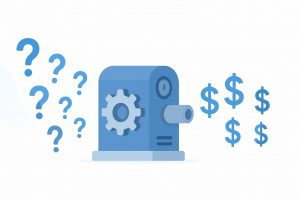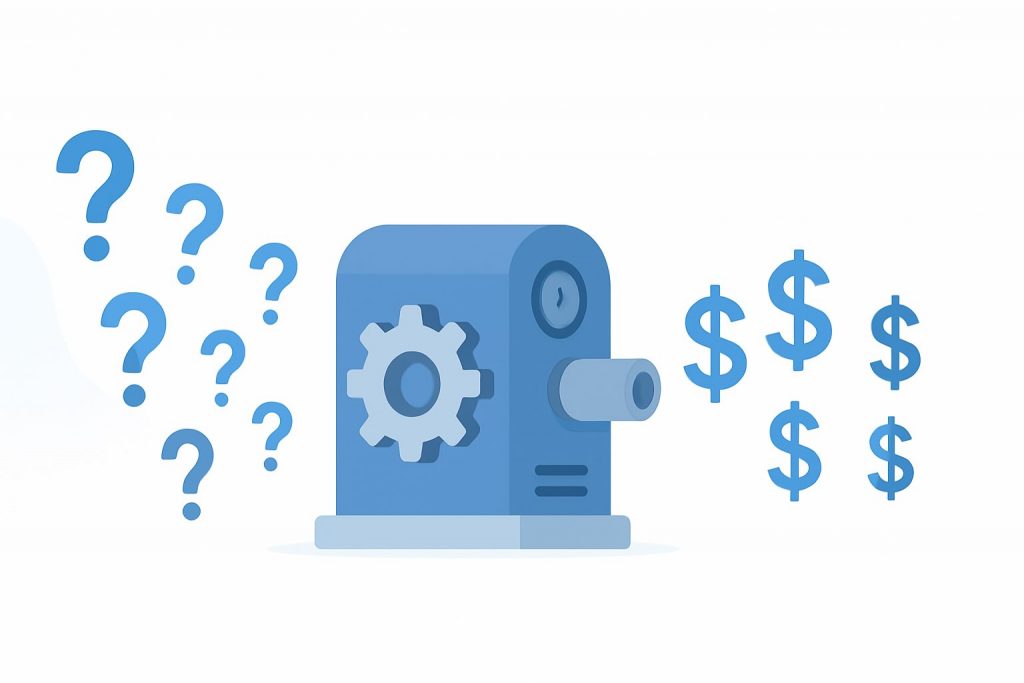Here’s something I’ve learned the hard way as CMO at two different companies that attempted to tackle this issue: it’s a potential goldmine that most aren’t aware of. Most organizations leave 15-25% of potential revenue untapped in their support channels because they’ve never figured out how to bridge the natural divide between sales and support teams.
And let me be brutally honest – I’ve had mixed success at best trying to solve this problem. The theory is beautiful. The execution? That’s where things get messy.
These teams have completely different DNA, but it goes deeper than that. Sales hunts for revenue while support guards customer satisfaction. They speak different languages, operate on different timelines and often view each other with suspicion. But the real killer isn’t the natural friction, it’s the conflicting incentives that make collaboration nearly impossible.
The companies that crack sales support integration see dramatically faster growth. We’re talking about transforming support interactions from cost centers into revenue-generating engines without compromising service quality. But before you get excited about the potential, let me tell you what you’re really up against. It’s harder than almost any other organizational change I’ve attempted, and the failure rate is depressingly high.
The real problem: everyone has conflicting incentives
Let’s talk numbers, because that’s what matters here. For a growth-stage SaaS company, poor sales support integration typically costs significant missed expansion revenue annually. That’s real money that scales with your business.
But here’s what I learned after trying to fix this at two different companies: the revenue leak isn’t the real problem. The real problem is that everyone’s incentives are fundamentally misaligned, and changing that requires political capital most leaders don’t have.
Your support team is getting hammered by their manager to close cases quickly and maintain high CSAT scores. Every minute they spend qualifying an expansion opportunity is a minute that hurts their individual performance metrics. When you ask them to “just spend a few extra minutes” identifying sales opportunities, you’re literally asking them to sacrifice their bonuses.
Your sales team has their own quota pressures and commission structures. They don’t want to waste time on leads that might not be qualified, especially if those leads come with existing customer baggage and expectations. They’d rather work fresh prospects who don’t already have opinions about your product and pricing.
And your finance person? They’re looking at the significant investment required for integration technology and asking why you can’t just “tell people to work together better.” They want to see guaranteed ROI before approving any investment, but integration benefits are notoriously hard to measure in the short term.
I’ve been in those budget meetings where everyone nods along about the importance of “customer-centricity” and then immediately shoots down any initiative that costs money or changes how people are evaluated. It’s maddening.
What I learned from two attempts (one decent success, one disappointing struggle)
After trying this twice with very different outcomes, here’s what actually happened and what I learned.
My first attempt was for a single service, and we had decent success. The challenge was keeping the support team focused on it. They would focus on it when it was a hot topic and then it would dry up. We also saw massive differences across different support agents, and even that changed over time. The superstars would slack off once it didn’t seem important anymore. Consistency was our biggest enemy.
My second attempt was actually worse. What I wrote about the sales team sticking their nose up at the leads and the support team resisting anything that impacted their metrics was completely true. It was a modest success for a while, but we by no means met our potential. The sales team complained about lead quality. The support team gamed the system to hit their metrics while doing the minimum on qualification. Leadership attention drifted to other priorities.
But here’s what I’m confident about: the opportunity was very real. When it worked, it really worked. The revenue impact was meaningful and the customer experience was better. Companies like HubSpot are masters at this, showing the world what’s possible when you get the incentives and processes aligned properly.
The problem isn’t that sales support integration doesn’t work. The problem is that it requires sustained organizational commitment and most companies aren’t willing to pay that price. We certainly weren’t, at least not consistently enough to make it stick.
The reality of trying to implement sales support integration
Here’s what actually happens when you try to implement this stuff. I’m going to be completely honest about my experience because most articles about this topic are written by consultants who’ve never had to live with the consequences.
Month 1-2: Everyone’s excited. You get buy-in from leadership, people attend the meetings, there’s genuine enthusiasm about “breaking down silos” and “putting customers first.” The kickoff meetings go great.
Month 3-4: Reality sets in. Support agents start complaining that the new qualification process is slowing them down and hurting their metrics. Sales reps say the leads from support are “not qualified” and want to focus on their existing pipeline. Finance starts asking pointed questions about when they’ll see ROI from the technology investments.
Month 5-6: The blame game begins. Support says sales isn’t following up quickly enough. Sales says support isn’t qualifying properly. Everyone points to the technology and says it’s not working as promised. Meanwhile, customer satisfaction starts declining because handoffs are taking longer, not shorter.
Month 7-8: Backsliding. People start finding workarounds to avoid the new processes. “Emergency” cases bypass the qualification framework. The CRM data gets sloppy because people are rushing through required fields. Leadership attention moves to other priorities.
Month 9-12: Quiet abandonment. Nobody officially kills the initiative, but it slowly dies. Some of the technology sticks around because it’s already paid for, but the behavior changes disappear. Everyone goes back to their old ways, and six months later someone suggests “we should really improve sales and support alignment.”
Sound familiar? This is what happened at both companies where I tried to tackle this problem. The second time was marginally better because I learned from the first disaster, but it was still brutally difficult.
What to measure (and what to ignore)
The difference between successful and failed sales support integration initiatives usually comes down to measurement. You need both leading indicators that predict success and lagging indicators that confirm results, with shared metrics that align both teams rather than creating competing priorities.
Net Revenue Retention (NRR) should be your north star metric. Growth-stage SaaS companies should target 110% or higher. This metric captures both retention and expansion, making it impossible for either team to succeed in isolation. Both teams share accountability—support prevents churn through proactive intervention while sales drives expansion through upselling and cross-selling. Companies with strong alignment typically achieve 115-125% NRR, compared to 95-105% for siloed teams.
Customer Health Scores provide early warning systems for both retention risks and expansion opportunities. These combine product usage data (login frequency, feature adoption, user growth), support interactions (ticket volume, satisfaction ratings, escalation patterns), and commercial engagement (contract value, payment history, sales engagement). When health scores drop below thresholds, they trigger joint intervention protocols where support and sales collaborate to address issues before they become churn risks.
Pipeline velocity from support-originated leads offers a powerful leading indicator. Support-qualified opportunities should move through the sales pipeline 20-30% faster than traditional leads because they come with rich context, demonstrated need, and existing relationships. Track not just volume but progression through each pipeline stage, win rates, and average deal sizes. Top performers see support-influenced deals close at 35-50% win rates, compared to 20-25% for cold outbound.
The ROI calculation is straightforward in theory. A typical growth-stage company investing in proper integration can expect strong returns within 12-18 months through improved retention, faster expansion sales, and better operational efficiency. The challenge is that finance wants to see the numbers upfront, but the benefits are largely qualitative until the system starts working.
Avoid the common measurement mistakes I see all the time: metric overload (limit dashboards to 5-7 core metrics), gaming the system (balance quantitative with qualitative assessments), lagging indicator dependency (use a 70/30 split between leading and lagging metrics), and attribution conflicts (implement “revenue influenced” rather than “revenue sourced” models that encourage collaboration).
Learning from both wins and failures
The difference between theory and practice becomes clear when you look at real companies that have tried this. IBM’s integration shows what enterprise-scale success looks like. With 250,000 employees sending over 9 million messages daily, they created dedicated Slack channels for each sales opportunity with automatic triggers that bring in support experts based on skills. This “customer swarming” approach cut 4 days from average deal cycles while improving both win rates and case resolution times.
HubSpot built their entire business model around aligned revenue teams, requiring sales reps’ career progression to be tied to customer retention rates. This radical alignment of incentives, combined with a unified platform strategy, enabled them to cut sales costs for converting leads by 50%. Their approach proves that true integration requires more than technology—it demands fundamental changes to how teams are evaluated and rewarded.
But the failures are equally instructive. Most sales support integration efforts fail, usually due to human factors rather than technical issues. Common patterns include blame cultures where teams fault “the system” rather than addressing process issues, change resistance from staff reluctant to adopt new workflows, and leadership misalignment where executives aren’t fully committed.
Poor handoff processes create the worst customer experiences: being asked the same questions multiple times, support teams being unaware of sales promises, and that immediate mood deflation when customers realize they’re starting over with a new team.
Salesforce implementation failures offer particularly valuable lessons. Organizations invest heavily but fail to achieve ROI due to overly complex configurations that discourage adoption, poor data discipline, and app overload from too many integrated tools. Recovery requires simplifying interfaces, implementing strict data governance, and prioritizing essential integrations.
Should you even attempt this?
Now that I’ve painted a realistic picture of how difficult this is, let me help you decide if it’s worth attempting at your company.
Don’t even start if:
- Your CEO won’t personally champion this initiative and make tough decisions about conflicting priorities
- You’re not willing to change compensation and evaluation criteria for both sales and support teams, at least the ones directly involved with these leads
- Your current tools and processes are a mess – fix those foundational issues first
- You don’t have the budget and timeline to dedicate to this properly
- Your teams actively dislike each other (you need to solve the relationship problems first)
Consider it only if:
- You have strong executive sponsorship and the CEO is willing to break ties when teams disagree
- You’re prepared to lose some good people who can’t adapt to the new way of working
- You have clean data in your CRM and support systems, or you’re willing to invest in fixing that first
- You can start with a narrow scope (high-value accounts only) and expand gradually
- You have a finance partner who understands the long-term ROI, not just the upfront costs
You might succeed if:
- Your company culture already values collaboration over individual achievement
- You have a track record of successfully implementing other cross-functional initiatives
- Your support and sales teams are already reasonably aligned and just need better processes
- You’re willing to measure ruthlessly and adjust constantly based on real data
- You can afford to iterate for months before expecting meaningful results
Be brutally honest about where your organization stands. I’ve seen too many companies waste time and money on this because they underestimated the political and organizational challenges. The potential payoff is huge, but the execution is harder than almost any other growth initiative you’ll attempt.
My honest recommendation
Sales support integration represents a compelling opportunity to unlock revenue that’s already sitting in your support channels. The potential is real – I’ve seen it work. But it’s also one of the most politically challenging initiatives you’ll ever attempt.
If you’re not willing to change how people are compensated, lose some good people who can’t adapt, and invest months of serious effort, don’t bother starting. There are easier ways to grow revenue.
But if you have strong executive backing, a finance partner who understands the long-term value, and the stomach for a difficult organizational change, the payoff can be substantial. Just go in with your eyes wide open about what you’re signing up for.
Sources and Further Reading
Enterprise Sales Transformation Roadmap for CROs, Whatfix, 2024 – Comprehensive transformation guide with change management best practices
Sales and Customer Success Alignment: The Benefits and Best Practices, Momentum, 2024 – Comprehensive guide on aligning sales and customer success teams with practical frameworks
3 Critical Steps for Aligning Sales to Customer Success, Gainsight, 2024 – Detailed methodology for creating shared accountability between teams
B2B Sales & Marketing Alignment: 7 Timeless Strategies for Growth, Demandbase, 2025 – Strategic approaches for revenue team alignment with measurable outcomes
How 8 Brands Mastered Marketing and Sales Alignment, HubSpot – Real-world case studies of successful sales and marketing integration
Revenue Operations: The What, Best Practices & RevOps Guide, Gartner – Industry analysis on revenue operations and team integration





